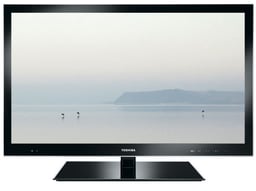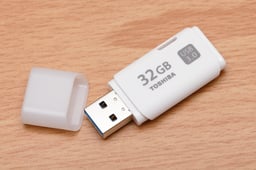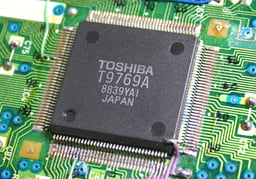Toshiba
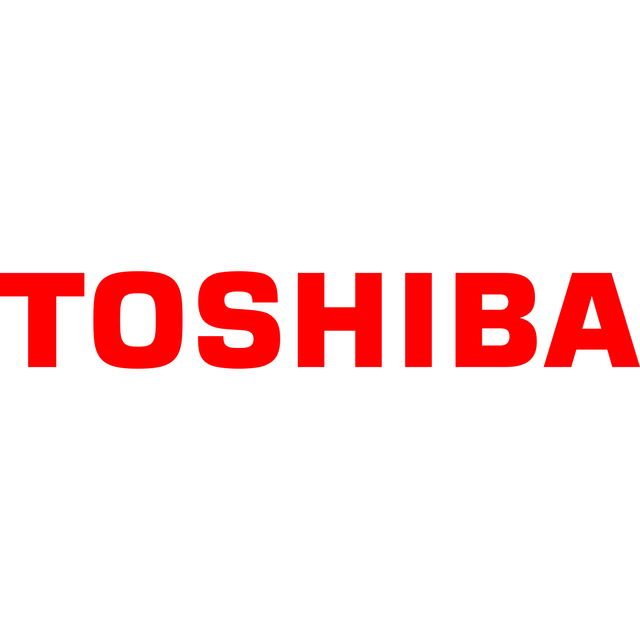
Toshiba

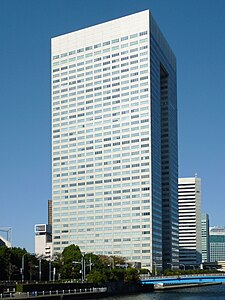 Toshiba Global Headquarters in Minato, Tokyo, Japan | |
Native name | 株式会社東芝 |
|---|---|
Romanized name | Kabushiki-gaisha Tōshiba |
Type | Public KK |
| Traded as | TYO: 6502 [111] |
| Industry | Conglomerate |
| Founded | July 1875 (1875-07)(as Tanaka Seisakusho) 1890 (1890)(Hakunetsu-sha & Co) 1939 (1939)(merger of Shibaura Seisaku-sho and Tokyo Denki) |
| Headquarters | Minato, Tokyo, Japan |
Area served | Worldwide |
Key people | Nobuaki Kurumatani (Chairman and CEO) Satoshi Tsunakawa (President and COO) |
| Products | Electronics Semiconductors Social infrastructure Computer hardware |
| Revenue | ¥3.693 trillion(2019)[1] |
Operating income | ¥35.7 million(2019)[1] |
Net income | ¥1.01 trillion(2019)[1] |
| Total assets | ¥4.297 trillion(2019)[1] |
| Total equity | ¥1.456 trillion(2019)[1] |
Number of employees | 141,256 (2019)[1] |
| Subsidiaries | Toshiba America, Inc. Toshiba Asia Pacific Pte., Ltd. Toshiba China Co., Ltd. Toshiba of Europe Ltd. (See full list) |
| Website | toshiba.co.jp [112] |
Toshiba Corporation (株式会社東芝, Kabushiki-gaisha Tōshiba, English: /təˈʃiːbə, tɒ-, toʊ-/[2]) is a Japanese multinational conglomerate headquartered in Tokyo, Japan. Its diversified products and services include information technology and communications equipment and systems, electronic components and materials, power systems, industrial and social infrastructure systems, consumer electronics, home appliances, medical equipment, office equipment, as well as lighting and logistics.
Toshiba was founded in 1939 as Tokyo Shibaura Denki K.K. through the merger of Shibaura Seisaku-sho (founded in 1875) and Tokyo Denki (founded in 1890). The company name was officially changed to Toshiba Corporation in 1978.
It is listed on the Tokyo Stock Exchange, where it is a constituent of the Nikkei 225 and TOPIX indices, the Osaka Securities Exchange and the Nagoya Stock Exchange. Toshiba is the ninth largest semiconductor manufacturer in the world.[3] In 2017, Toshiba filed unaudited quarterly results because of uncertainties at Westinghouse, which had filed for Chapter 11 bankruptcy protection. Toshiba stated that "substantial doubt about the company's ability to continue as a going concern exists".[4]
 Toshiba Global Headquarters in Minato, Tokyo, Japan | |
Native name | 株式会社東芝 |
|---|---|
Romanized name | Kabushiki-gaisha Tōshiba |
Type | Public KK |
| Traded as | TYO: 6502 [111] |
| Industry | Conglomerate |
| Founded | July 1875 (1875-07)(as Tanaka Seisakusho) 1890 (1890)(Hakunetsu-sha & Co) 1939 (1939)(merger of Shibaura Seisaku-sho and Tokyo Denki) |
| Headquarters | Minato, Tokyo, Japan |
Area served | Worldwide |
Key people | Nobuaki Kurumatani (Chairman and CEO) Satoshi Tsunakawa (President and COO) |
| Products | Electronics Semiconductors Social infrastructure Computer hardware |
| Revenue | ¥3.693 trillion(2019)[1] |
Operating income | ¥35.7 million(2019)[1] |
Net income | ¥1.01 trillion(2019)[1] |
| Total assets | ¥4.297 trillion(2019)[1] |
| Total equity | ¥1.456 trillion(2019)[1] |
Number of employees | 141,256 (2019)[1] |
| Subsidiaries | Toshiba America, Inc. Toshiba Asia Pacific Pte., Ltd. Toshiba China Co., Ltd. Toshiba of Europe Ltd. (See full list) |
| Website | toshiba.co.jp [112] |
History
Tanaka Seisakusho
Tanaka Seisakusho (田中製作所, Tanaka Engineering Works) was the first company established by Tanaka Hisashige, one of the most original and productive inventor-engineers during the Tokugawa / Edo period. Established in July 1875, it was the first Japanese company to manufacture telegraph equipment. It also manufactured switches, and miscellaneous electrical and communications equipment. The company was inherited by Tanaka's adopted son, and later became half of the present Toshiba company. Several people who worked at Tanaka Seisakusho or who received Tanaka's guidance at a Kubusho (Ministry of Industries) factory later became pioneers themselves. These included Miyoshi Shōichi who helped Fujioka make the first power generator in Japan and to establish a company, Hakunetsusha to make bulbs; Oki Kibatarō, the founder of the present Oki Denki (Oki Electric Industry); and Ishiguro Keizaburō, a co-founder of the present Anritsu.[7]
After the demise of the founder in 1881 Tanaka Seisakusho became partly owned by General Electric and expanded into the production of torpedoes and mines at the request of the Imperial Japanese Navy, to become on the largest manufacturing companies of the time. However, as the Navy started to use competitive bids and then build its own works, the demand decreased substantially and the company started to lose money. The main creditor to the company, Mitsui Bank, took over the insolvent company in 1893 and renamed it Shibaura Seisakusho (Shibaura Engineering Works).[7]
Shibaura Seisakusho
Shibaura Seisakusho (芝浦製作所, Shibaura Engineering Works) was the new name given to the company Tanaka Seisakusho (Tanaka Engineering Works), after it was declared insolvent in 1893 and taken over by Mitsui Bank.
In 1910, it formed a tie-up with GE USA, which, in exchange for technology acquired about a quarter of the shares of Shibaura. With this investment GE now had a stake in both Tokyo Denki and Shibaura Seisakusho - two companies that had a complementary line of products in light as well as heavy electrical equipment. Both companies were merged in 1939 to create Tokyo Shibaura Denki (Tokyo Shibaura Electric Company, now Toshiba). The relation with GE continued until the beginning of the war and, after the war, resumed in 1953 with GE's 24 percent shareholding. This percentage has, however, decreased substantially since then.[7]
Hakunetsusha (Tokyo Denki)
Hakunetsusha (白熱舎) was a company established by Shōichi Miyoshi and Fujioka Ichisuke, two of Japan's industrial pioneers during the Tokugawa / Edo period. It specialized in the manufacture of light bulbs.
The company was established in 1890, and started out by selling bulbs using bamboo filaments. However, following the opening up of trade with the West through the Unequal treaty, Hakunetsusha met with fierce competition from imports. Its bulb cost about 60 per cent more than the imports and the quality was poorer. The company managed to survive with the booms after the First Sino-Japanese War of 1894–95 and the Russo-Japanese War of 1904–05, but afterward its financial position was precarious.
In 1905 the company was renamed Tokyo Denki (Tokyo Electric) and entered into a financial and technological collaboration with General Electric of USA. General Electric acquired 51 percent share of ownership, sent a vice president, and provided the technology for bulb-making. Production equipment was bought from GE and Tokyo Denki soon started selling its products with GE's trademark.
In 1939, Tokyo Denki and Shibaura Seisakusho were merged to form Tokyo Shibaura Denki (Tokyo Shibaura Electric Company, now Toshiba).
1939 to 2000

The Toshiba pavilion at Expo '85.

In 1950, Tokyo Shibaura Denki was renamed Toshiba. This logo was used from 1950-1969. It was also used later on for hard drives .[9]

Toshiba logo used from 1969 to 1984.[10]

Toshiba logo, used since 1984.[10]
Toshiba was founded in 1939 by the merger of Shibaura Seisakusho (Shibaura Engineering Works)[8] and Tokyo Denki (Tokyo Electric). Shibaura Seisakusho had been founded as Tanaka Seisakusho by Tanaka Hisashige in July 1875 as Japan's first manufacturer of telegraph equipment.[7] In 1904, it was renamed Shibaura Seisakusho. Through the first decades of the 20th century, Shibaura Seisakusho had become a major manufacturer of heavy electrical machinery as Japan modernized during the Meiji Era and became a world industrial power. Tokyo Denki was founded as Hakunetsusha in 1890 and had been Japan's first producer of incandescent electric lamps. It later diversified into the manufacture of other consumer products and in 1899 had been renamed Tokyo Denki. The merger of Shibaura and Tokyo Denki created a new company called Tokyo Shibaura Denki (Tokyo Shibaura Electric) (東京 芝浦 電気). It was soon nicknamed Toshiba, but it was not until 1978 that the company was officially renamed Toshiba Corporation.
The group expanded rapidly, driven by a combination of organic growth and by acquisitions, buying heavy engineering and primary industry firms in the 1940s and 1950s. Groups created include Toshiba Music Industries/Toshiba EMI (1960), Toshiba International Corporation (1970s) Toshiba Electrical Equipment (1974), Toshiba Chemical (1974), Toshiba Lighting and Technology (1989), Toshiba America Information Systems (1989) and Toshiba Carrier Corporation (1999).
Toshiba is responsible for a number of Japanese firsts, including radar (1912), the TAC digital computer (1954), transistor television and microwave oven (1959), color video phone (1971), Japanese word processor (1978), MRI system (1982), laptop personal computer (1986), NAND EEPROM (1991), DVD (1995), the Libretto sub-notebook personal computer (1996) and HD DVD (2005).
In 1977, Toshiba acquired the Brazilian company Semp (Sociedade Eletromercantil Paulista), subsequently forming Semp Toshiba through the combination of the two companies' South American operations.
In 1987, Tocibai Machine, a subsidiary of Toshiba, was accused of illegally selling CNC milling machines used to produce very quiet submarine propellers to the Soviet Union in violation of the CoCom agreement, an international embargo on certain countries to COMECON countries. The Toshiba-Kongsberg scandal involved a subsidiary of Toshiba and the Norwegian company Kongsberg Vaapenfabrikk. The incident strained relations between the United States and Japan, and resulted in the arrest and prosecution of two senior executives, as well as the imposition of sanctions on the company by both countries.[11] Senator John Heinz of Pennsylvania said "What Toshiba and Kongsberg did was ransom the security of the United States for $517 million."
2000 to 2010
In 2001, Toshiba signed a contract with Orion Electric, one of the world's largest OEM consumer video electronic makers and suppliers, to manufacture and supply finished consumer TV and video products for Toshiba to meet the increasing demand for the North American market. The contract ended in 2008, ending seven years of OEM production with Orion.
In December 2004, Toshiba quietly announced it would discontinue manufacturing traditional in-house cathode-ray tube (CRT) televisions. In 2006, Toshiba terminated production of in-house plasma TVs. To ensure its future competitiveness in the flat-panel digital television and display market, Toshiba has made a considerable investment in a new kind of display technology called SED. Before World War II, Toshiba was a member of the Mitsui Group zaibatsu (family-controlled vertical monopoly). Today Toshiba is a member of the Mitsui keiretsu (a set of companies with interlocking business relationships and shareholdings), and still has preferential arrangements with Mitsui Bank and the other members of the keiretsu. Membership in a keiretsu has traditionally meant loyalty, both corporate and private, to other members of the keiretsu or allied keiretsu. This loyalty can extend as far as the beer the employees consume, which in Toshiba's case is Asahi.
In July 2005, BNFL confirmed it planned to sell Westinghouse Electric Company, then estimated to be worth $1.8 billion (£1 billion).[12] The bid attracted interest from several companies including Toshiba, General Electric and Mitsubishi Heavy Industries and when the Financial Times reported on 23 January 2006 that Toshiba had won the bid, it valued the company's offer at $5 billion (£2.8 billion). The sale of Westinghouse by the Government of the United Kingdom surprised many industry experts, who questioned the wisdom of selling one of the world's largest producers of nuclear reactors shortly before the market for nuclear power was expected to grow substantially; China, the United States and the United Kingdom are all expected to invest heavily in nuclear power.[13] The acquisition of Westinghouse for $5.4 billion was completed on 17 October 2006, with Toshiba obtaining a 77 percent share, and partners The Shaw Group a 20 percent share and Ishikawajima-Harima Heavy Industries Co. Ltd. a 3 percent share.
In late 2007, Toshiba took over from Discover Card as the sponsor of the top-most screen of One Times Square in New York City.[14] It displays the iconic 60-second New Year's countdown on its screen, as well as messages, greetings, and advertisements for the company. It was taken over by Capital One in late 2018.
2010 to 2013
Toshiba announced on 16 May 2011, that it had agreed to acquire all of the shares of the Swiss-based advanced-power-meter maker Landis+Gyr for $2.3 billion.[17] In 2010 the company released a series of television models including the WL768, YL863, VL963 designed in collaboration with Danish designer Timothy Jacob Jensen.[18] In April 2012, Toshiba agreed to acquire IBM's point-of-sale business for $850 million, making it the world's largest vendor of point-of-sale systems.[19][20]
In December 2013, Toshiba completed its acquisition of Vijai Electricals Limited plant at Hyderabad and set up its own base for manufacturing of transmission and distribution products (transformers and switchgears) under the Social Infrastructure Group in India as Toshiba Transmission & Distribution Systems (India) Private Limited.
2014 OCZ Storage Solutions Acquisition

In January 2014, Toshiba completed its acquisition of OCZ Storage Solutions.[23] OCZ Technology stock was halted on 27 November 2013. OCZ then stated they expected to file a petition for bankruptcy and that Toshiba Corporation had expressed interest in purchasing its assets in a bankruptcy proceeding.[24][25] On 2 December 2013, OCZ announced Toshiba had agreed to purchase nearly all of OCZ's assets for $35 million.[26] The deal was completed on 21 January 2014 when the assets of OCZ Technology Group became a new independently-operated subsidiary of Toshiba named OCZ Storage Solutions.[27] OCZ Technology Group then changed its name to ZCO Liquidating Corporation;[28] on 18 August 2014, ZCO Liquidating Corporation and its subsidiaries were liquidated.[29] OCZ Storage Solutions was dissolved on 1 April 2016 and absorbed into Toshiba America Electronic Components, Inc.,[30][31] with OCZ becoming a brand of Toshiba.
In March 2014, Toshiba sued SK Hynix accusing the company for stealing technology of their NAND flash memory.[32]
Toshiba announced in early 2015 that they would stop making televisions in its own factories. From 2015 onward, Toshiba televisions will be made by Compal for the U.S., or by Vestel and other manufacturers for the European market.
In January 2016, Toshiba's security division unveiled a new bundle of services for schools that use its surveillance equipment. The program, which is intended for both K-12 and higher education, includes education discounts, alerts and post-warranty support, among other features, on its IP-based security gear.[34]
As of March 2016, Toshiba is preparing to start construction on a cutting-edge new semiconductor plant in Japan that will mass-produce chips based on the ultra-dense flash variant. Toshiba expects to spend approximately 360 billion yen, or $3.2 billion, on the project through May 2019.[35]
In April 2016, Toshiba recalled 100,000 faulty laptop lithium-ion batteries, which are made by Panasonic, that can overheat, posing burn and fire hazards to consumers, according to the U.S. Consumer Product Safety Commission. Toshiba first announced the recall in January, and said it was recalling the batteries in certain Toshiba Notebook computers sold since June 2011.[36]
In late December 2016 Toshiba announced losses in the Westinghouse subsidiary from nuclear plant construction would lead to a write-down of several billion dollars.[38]
In January 2017, a person with direct knowledge of the matter reported that the company plans on making its chip division a separate business.[39]
2015 accounting scandal
Toshiba first announced in May 2015 that it was investigating an accounting scandal and it might have to revise its profits for the previous three years.[40][41] On 21 July 2015, CEO Hisao Tanaka announced his resignation amid an accounting scandal that he called "the most damaging event for our brand in the company's 140-year history". Profits had been inflated by $1.2 billion over the previous seven years.[42] Eight other senior officials also resigned, including the two previous CEOs.[43] Chairman Masashi Muromachi was appointed acting CEO.[44] Following the scandal, Toshiba Corp. was removed from a stock index showcasing Japan's best companies. That was the second reshuffle of the index, which picks companies with the best operating income, return on equity and market value.[45]
In September 2015, Toshiba shares fell to their lowest point in two and a half years. The firm said in a statement that its net losses for the quarterly period were 12.3 billion yen ($102m; £66m). The company noted poor performances in its televisions, home appliances and personal computer businesses.[46]
In December 2015, Muromachi said the episode had wiped about $8 billion off Toshiba's market value. He forecast a record 550 billion yen (about US $4.6 billion) annual loss and warned the company would have to overhaul its TV and computer businesses. Toshiba would not be raising funds for two years, he said. The next week, a company spokesperson announced Toshiba would in early 2016 seek 300 billion yen ($2.5 billion), taking the company's indebtedness to more than 1 trillion yen (about $8.3 billion).[47]
2017 US nuclear construction liabilities
In February 2017, Toshiba revealed unaudited details of a 390 billion yen ($3.4 billion) corporate wide loss, mainly arising from its majority owned US based Westinghouse nuclear construction subsidiary which was written down by 712 billion yen ($6.3 billion). On 14 February 2017, Toshiba delayed filing financial results, and chairman Shigenori Shiga, formerly chairman of Westinghouse, resigned.[50][51][52]
Construction delays, regulatory changes and cost overruns at Westinghouse built nuclear facilities Vogtle units 3 and 4 in Waynesboro, Georgia and VC Summer units 2 and 3 in South Carolina, are cited as the main causes of the dramatic fall in Toshiba's financial performance and collapse in share price. Fixed priced construction contracts negotiated by Westinghouse with Georgia Power have left Toshiba with uncharted liabilities that will likely result in the sale of key Toshiba operating subsidiaries to secure the company's future.[53]
On 11 April 2017, Toshiba filed unaudited quarterly results. Auditors PricewaterhouseCoopers had not signed of the accounts because of uncertainties at Westinghouse. Toshiba stated that "substantial doubt about the company's ability to continue as a going concern exists".[4][57] On 25 April 2017, Toshiba announced its decision to replace its auditor after less than a year. Earlier in April, the company filed twice-delayed business results without an endorsement from auditor PricewaterhouseCoopers (PwC).[56][58]
On 20 September 2017, Toshiba's board approved a deal to sell its memory chip business to a group led by Bain Capital for US$18 billion, with financial backing by companies such as Apple, Dell Technologies, Hoya Corporation, Kingston Technology, Seagate Technology, and SK Hynix.[59][60] The newly-independent company was named Toshiba Memory.[61]
Later that month, the company announced that it would pull out of its long-standing sponsorships of the Japanese television programs Sazae-san, Nichiyō Gekijo, and the video screens topping out One Times Square in New York City. The company cited that the value of these placements were reduced by its exit from consumer-oriented lines of business.[62]
On 6 April 2018 Toshiba announced the completion of the sale of Westinghouse's holding company to Brookfield Business Partners and some partners.[63]
Present
On 1 October 2018 Toshiba Added Dynabook As A Laptop Series. the laptop branch name change Toshiba PC Group Inc. effective 1 September 2019, and from that point forward the. Dynabook and Satellite 'TecraandPortégélaptop lines are now continued under the Toshiba.
Operations

The Toshiba research and development facility in Kawasaki, Kanagawa, Japan
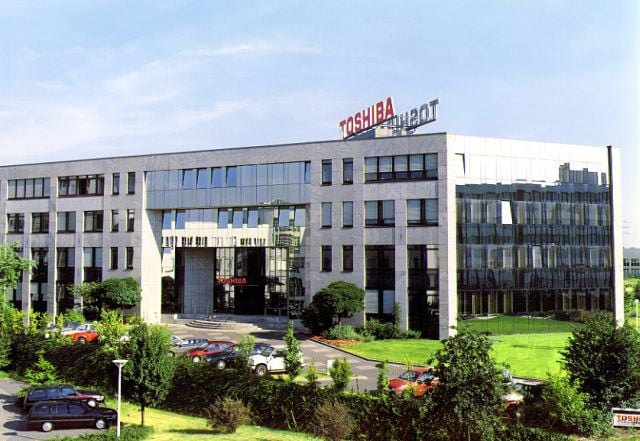
Toshiba Europe offices in Neuss, Germany
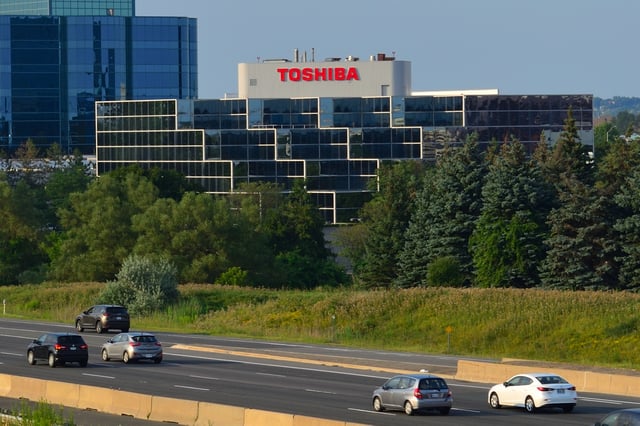
Toshiba Canada offices
Toshiba is headquartered in Minato-ku, Tokyo, Japan and has operations worldwide. It had around 141,256 employees as of 31 March 2018.[64]
Toshiba is organised into four main business groupings: the Digital Products Group, the Electronic Devices Group, the Home Appliances Group and the Social Infrastructure Group.[65] In the year ended 31 March 2012, Toshiba had total revenues of ¥6,100.3 billion, of which 25.2 percent was generated by the Digital Products Group, 24.5 percent by the Electronic Devices Group, 8.7 percent by the Home Appliances Group, 36.6 percent by the Social Infrastructure Group and 5 percent by other activities. In the same year, 45 percent of Toshiba's sales were generated in Japan and 55 percent in the rest of the world.[65]
Toshiba has 39 R&D facilities worldwide, which employ around 4,180 people.[65] Toshiba invested a total of ¥319.9 billion in R&D in the year ended 31 March 2012, equivalent to 5.2 percent of sales.[65] Toshiba registered a total of 2,483 patents in the United States in 2011, the fifth-largest number of any company (after IBM, Samsung Electronics, Canon and Panasonic).[65]
Principal business groupings, divisions and subsidiaries
Toshiba is organized into the following principal business groupings, divisions and subsidiaries:
Digital Products Group
- Digital Products and Services Company
- Samsung Corporation
- Toshiba PC Group Limited Inc .
Electronic Devices Group
- Semiconductor & Storage Products Company
- Discrete Semiconductor Division
- Analog & Imaging IC Division
- Logic LSI Division
- Storage Products Division
- Center For Semiconductor Research & Development
- Optical Disc Drive Division (Formed partnership with optical disc drive division ofSamsung ElectronicsasToshiba Samsung Storage Technology Corporation(TSST))[66][67][68]
- Toshiba Mobile Display Co., Ltd. (This company will be merged with Hitachi Displays, Ltd. and Sony Mobile Display Corporation to form Japan Display Inc. in Spring of 2012.[69])
Social Infrastructure Group
- Power Systems Company (Combined-cycle gas power plants, nuclear power plants, hydro-electric power plants, and associated components)
- Nuclear Energy Systems & Services Division
- Westinghouse Electric Company(acquired October 2006)
- Thermal & Hydro Power Systems & Services Division
- Power and Industrial Systems Research and Development Center
- Social Infrastructure Systems Company[70]
- Transmission & Distribution Systems Division
- Railway & Automotive Systems Division
- Railway Systems Division
- Automotive Systems Division
- Motor & Drive Systems Division
- Automation Products & Facility Solution Division
- Defense & Electronic Systems Division
- Environmental Systems Division
- Toshiba Elevator and Building Systems Corporation
- Toshiba Solutions Corporation
- Toshiba Medical Systems Corporation
- Toshiba America Information Systems
Home Appliances Group
- Toshiba Home Appliances Corporation
- Toshiba Lighting & Technology Corporation
- Harison Toshiba Lighting Corporation
- Toshiba Carrier Corporation
Others
- New Lighting Systems Division
- Smart Community Division
- Materials & Devices Division
Products, services and standards
Toshiba has a range of products and services, including air conditioners,[71] consumer electronics (including televisions and DVD and Blu-ray players),[72] control systems (including air-traffic control systems, railway systems, security systems and traffic control systems),[73] electronic point of sale equipment,[74] elevators and escalators,[75] home appliances (including refrigerators and washing machines),[71] IT services,[76] lighting,[71][77] materials and electronic components,[78] medical equipment (including CT and MRI scanners, ultrasound equipment and X-ray equipment),[79] office equipment,[74][80] business telecommunication equipment[81] personal computers,[72] semiconductors,[82] power systems (including electricity turbines, fuel cells and nuclear reactors)[83] power transmission and distribution systems,[73] and TFT displays.[84]
3D television
In October 2010, Toshiba unveiled the Toshiba Regza GL1 21" LED backlit LCD TV glasses-free 3D prototype at CEATEC 2010. This system supports 3D capability without glasses (utilising an integral imaging system of 9 parallax images with vertical lenticular sheet). The retail product was released in December 2010.[85]
4K Ultra HD televisions
4K Ultra HD (3840×2160p) televisions provides four times the resolution of 1080p Full HD televisions. Toshiba's 4K HD LED televisions are powered by a CEVO 4K Quad + dual-core processor.[86]
HD DVD

On 19 February 2008, Toshiba announced that it would be discontinuing its HD DVD storage format following defeat in a format "war" against Blu-ray.[87] The HD DVD format had failed after most of the major US film studios backed the Blu-ray format, which was developed by Sony, Panasonic, Philips and Pioneer Corporation. Conceding the abandonment of HD DVD, Toshiba's President, Atsutoshi Nishida said "We concluded that a swift decision would be best [and] if we had continued, that would have created problems for consumers, and we simply had no chance to win".[88]
Toshiba continued to supply retailers with machines until the end of March 2008, and continued to provide technical support to the estimated one million people worldwide who owned HD DVD players and recorders. Toshiba announced a new line of stand-alone Blu-ray players as well as drives for PCs and laptops, and subsequently joined the BDA, the industry body which oversees development of the Blu-ray format.[89]
REGZA

REGZA (Real Expression Guaranteed by Amazing Architecture) is a unified television brand owned and manufactured by Toshiba. In 2010 REGZA name disappeared from the North American market, and from March 2015[90] new TVs carrying the Toshiba name are designed and produced by Compal Electronics, a Taiwanese company, which Toshiba has licensed its name to. REGZA is also used in Android-based smartphones that were developed by Fujitsu Toshiba Mobile Communications.
Chromebook
3D flash memory
In March 2015, Toshiba announced the development of the first 48-layer, three-dimensional flash memory. The new flash memory is based on a vertical stacking technology that Toshiba calls BiCS (Bit Cost Scaling), stores two bits of data per transistor and can store 128Gbits (16GB) per chip.[92] Toshiba's memory division was spun off as Toshiba Memory Corporation.
Environmental record
Toshiba has been judged as making "low" efforts to lessen their impact on the environment. In November 2012, they came second from the bottom in Greenpeace's 18th edition of the Guide to Greener Electronics that ranks electronics companies according to their policies on products, energy and sustainable operations.[93] Toshiba received 2.3 of a possible 10 points, with the top company (WIPRO) receiving 7.1 points. "Zero" scores were received in the categories "Clean energy policy advocacy", "Use of recycled plastics in products" and "Policy and practice on sustainable sourcing of fibres for paper".
In 2010, Toshiba reported that all of its new LCD TVs comply with the Energy Star standards and 34 models exceed the requirements by 30% or more.[94]
Toshiba also partnered with China's Tsinghua University in 2008 in order to form a research facility to focus on energy conservation and the environment.[95] The new Toshiba Energy and Environment Research Center is located in Beijing where forty students from the university will work to research electric power equipment and new technologies that will help stop the global warming process.[95] Through this partnership, Toshiba hopes to develop products that will better protect the environment and save China.[95] This contract between Tsinghua University and Toshiba originally began in October 2007 when they signed an agreement on joint energy and environment research.[95] The projects that they conduct work to reduce car pollution and to create power systems that don’t negatively affect the environment.[95]
On 28 December 1970 Toshiba began the construction of unit 3 of the Fukushima Daiichi Nuclear Power Plant[96] which was damaged in the Fukushima I nuclear accidents on 14 March 2011. In April 2011, CEO Norio Sasaki declared nuclear energy would "remain as a strong option" even after the Fukushima I nuclear accidents.[97]
In late 2013, Toshiba (Japan) entered the solar power business in Germany, installing PV systems on apartment buildings.[98]
Slogans
"Ello Tosh, Gotta Toshiba?" (1985- UK)
"In Touch With Tomorrow" (1984–2006)
"Dunia Mengakuinya" (English: "The World Acknowledges It", 1984–2006, Indonesia only)
"Leading Innovation" (2006–present)
See also
List of Toshiba subsidiaries
Toshiba Memory Corporation, spun off as an independent company
List of Texas companies (T)


